Contrary to expectations, tablets are quite popular with a large segment of users. They are also great as gifts. However, deciding on a popular and feature-packed tablet to suit your pocket can be a chore. We present a selection of the top Android tablets of 2018 to save you the trouble of deciding on one.
So what is the best or the ultimate Android tablet to buy right now? New devices are coming out almost every month, and it’s quite challenging to even discover what is out there and decide on ‘The Ultimate Value-for-Money Android Tablet’. Android tablets make a great gift for children or grandparents. With the Android OS, they ensure seamless integration with the Google ecosystem. Currently, there are probably hundreds of tablets available on e-commerce shopping portals—some of them are overpriced, some offer poor value for money, and some are really good; so it is somewhat cumbersome to determine the best tablet to grab.
In this article, the top Android tablets of 2018 are lined up, along with their technical specifications, pros and cons, to provide a one-stop guide to buyers.
Samsung Galaxy Tab S4 is the ultimate flagship 26.67cm tablet that is aimed at people who require a device lighter than an ultrabook but with a keyboard and pen. This tablet tries to push Android tablets to the next level with its two-in-one desktop-like software, and is preferred by business and enterprise customers who want to replace their laptops with tablets.
In 2018, Samsung upgraded the Galaxy Tab S series by altering the device’s form factor, switching from the 4:3 to the 16:10 aspect ratio with a Super AMOLED display, which is 26.67cm in size with narrower bezels. The tablet is equipped with the Qualcomm Snapdragon 835 SoC to provide high system performance with 4GB RAM and a 7300mAh battery with DeX mode.
- Dimensions (H x W x D; weight): 249.3mm x 164.3mm x 7.1mm; 483g
- CPU: 2.35GHz Qualcomm Snapdragon 835 SoC, octa-core
- Display: 26.6cm with Super AMOLED HDR 2560 x 1600 (WQXGA), aspect ratio of 16:10
- Camera: 13MP (main camera + auto focus) with f/1.9 and Flash. Front camera: 8MP and supports UHD 4K video recording at 3840 x 2160 @30 fps
- Memory: 4GB RAM, 64GB ROM with microSD card support of up to 400GB
- Connectivity: ANT+, USB 3.1, 3.5mm jack, Wi-Fi Direct, Bluetooth 5.0, 802.11 a/b/g/n/ac 2.4G+ 5G, Smart Switch PC Sync, GPS, GLONASS, BEIDOU, Galileo
- Sensors: Accelerometer, gyro sensor, geomagnetic sensor, Hall sensor, IRIS sensor, RGB light sensor, proximity sensor
- Speakers: Four speakers – surround sound with Dolby Atmos
- Battery: 7300mAh
- Software: Android 8.1 Oreo
- Stylus: S-Pen
Pros: Sharp display, best camera for tablets, PC-desktop-like DeX, excellent battery, Quad speakers with good stereo split
Cons: Only 4GB RAM, DeX has limitations and requires better app support; is expensive, and keyboard accessory costs extra
Amazon Fire HD 8 (2018) is one of the cheapest tablets that money can buy from a recognisable brand. It is perfect for those who want a cheap, yet good quality tablet primarily for media consumption and reading. The 2018 version of Amazon Fire HD 8 has small upgrades like a better front-facing camera and the use of Alexa voice commands even with the screen on standby. The Fire HD 8 tablet, along with the Show Mode charging dock accessory, allows users to turn the device into an Echo Show.
- Dimensions (H x W x D; weight): 128mm x 214mm x 9.7mm; 363g
- CPU: 1.3GHz quad-core
- Display: 20.3cm HD screen with 1280 x 800px resolution, 189ppi
- Camera: 2MP front + rear camera
- Memory: 1.5GB RAM, 16/32GB ROM with microSD card support of up to 400GB
- Connectivity: Wi-Fi 802.11a/b/g/n with support for WEP, WPA and WPA2 security, USB 2.0 micro-B connector, 3.5mm audio jack, Bluetooth with A2DP compatible stereo, location based services via Wi-Fi
- Sensor: Accelerometer, ambient light sensor
- Battery: 10 hours of battery life (based on average usage)
- Software: Fire OS 6
Pros: Durable body, Echo Show compatible, simple GUI, strong Alexa integration, good battery life, cheap and affordable, best e-book reader
Cons: Less apps support, sluggish performance, no GPS
Huawei MediaPad M5 Pro is a strong challenger to the iPad. The tablet is equipped with a detachable keyboard making this an awesome productivity tool and ideal as a multimedia device for watching HD movies. MediaPad M5 Pro is not only thin, light and attractive but has a superb design from the usability point of view. With a 16:10 aspect ratio, the tablet offers a display of 27.4cm with a 2560 x 1600 resolution enhanced by ClariVu technology, with no compromises on contrast. It is light enough to carry around like any other tablet.
- Dimensions (W x H x D; weight): 258.7mm x 171.8mm x 7.3mm; 498g
- CPU: Huawei HiSilicon KIRIN 960, 4 x 2.36GHz ARM Cortex-A73, 4 x 1.84GHz ARM Cortex-A53, octa-core
- Display: 27.4cm 2560 x 1600px with enhanced ClariVu display
- Camera: 13MP f/2.2 with auto focus (rear) + 8MP f/2.2 (front)
- Memory: 4GB RAM, 64GB ROM, support for microSD, microSDHC and microSDXC
- Connectivity: Wi-Fi a/b/g/n/ac (2.4G + 5G), dual band, Wi-Fi hotspot, Wi-Fi-Direct, Bluetooth 4.2, USB 2.0, USB Type-C, GPS, A-GPS, GLONASS and BEIDOU
- Sensors: Gravity, ambient light, compass, gyroscope, fingerprint, Hall effect, status indicator
- Speakers: Quad stereo speaker with Huawei Histen sound effect and support for hi-res audio
- Battery: 7500mAh
- Software: Android 8.0 Oreo
- Stylus: M-Pen
Pros: Display of 2k, good battery life of 11+ hours with Quick Charge, good speaker sound, snappy performance, good camera, LTE functionality
Cons: No flashlight, no 3.5mm audio jack, less internal storage, Wi-Fi connectivity issues
Google Pixel Slate is an Android Mobile productivity device from Google, which combines the design and appeal of a flagship two-in-one tablet. Like Apple’s iPad Pro and Microsoft’s Surface Pro, the Pixel Slate is a tablet designed to pair with a keyboard to become more like a laptop. It relies on the Chrome OS.
![]() On paper, the Pixel Slate looks like a capable product similar to the Pixel 3 smartphone. But in reality, it is just another tablet biting off more than it can chew. While it handles Web browsing just fine, its efficiency drops as soon as you exit its Google Chrome browser, its great ideas hamstrung both by Google’s software decisions and a small platoon of bugs.
On paper, the Pixel Slate looks like a capable product similar to the Pixel 3 smartphone. But in reality, it is just another tablet biting off more than it can chew. While it handles Web browsing just fine, its efficiency drops as soon as you exit its Google Chrome browser, its great ideas hamstrung both by Google’s software decisions and a small platoon of bugs.
The Pixel Slate is a sleek-looking tablet, clearly designed to be used while connected to a keyboard case. The entire front is covered in a sheet of glass, while the rounded edges and flat back are aluminium. Both the front and rear cameras are 8MP and sit flush with the Slate’s body. On either side of the display sits a front-facing speaker, perfect for blasting audio right at your face instead of off to the side. In terms of performance, the cheapest Pixel Slate features a paltry 32GB of storage and an Intel Celeron processor.
Technical specifications
- Dimensions (L x W x H; weight): 202.04mm x 290.85mm x 7.0mm; 0.7kg
- CPU: 8th generation core m3/ i5 / i7 processor/Intel Celeron processor
- Display: 31.2cm molecular display with 3000 x 2000 resolution LTPS LCD with Corning Gorilla Glass 5
- Camera: 8MP f/1.9 front + rear camera with 1080p 30fps video recording capability
- Memory: 4GB, 8GB and 16GB
- Connectivity: Wi-Fi 802.11 a/b/g/n/ac, 2×2 MIMO, dual-band, 2-USB C for charging, 4K display output, Bluetooth 4.2
- Sensors: Fingerprint, 3-axis gyroscope/accelerometer
- Speakers: Dual front-firing speakers for surround sound, two microphones for noise cancellation
- Battery: 48WHr battery
- Software: Chrome OS
Pros: Vibrant display, loud speakers, good performance, responsive fingerprint sensor, support for Pixel Book Pen, long battery life
Cons: Expensive compared to competitors, pricey accessories, no headphone jack, no expandable storage
Royole FlexPai FlexPai is the world’s first commercial foldable smartphone-cum-tablet with a flexible display. It is like any other phone with great style. When folded out the device offers a 19.8cm display, which sits firmly in the ‘small tablet’ territory, with a 1,920 x 1,440-pixel resolution. Folded up, the FlexPai suddenly delivers two displays — one with a 16:9 aspect ratio, and the other with an 18:9 aspect ratio. The FlexPai can automatically detect which display you’re using, turning the other one off. It can be folded from 0 to 180 degrees.
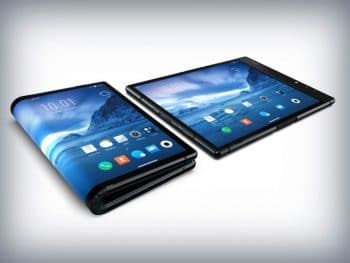 The company, Royole Corporation, claims it can fold and unfold 200,000 times, which means you could perform the move 50 times every day for nearly 55 years. The screen itself is a 1,920 x 1,080 AMOLED display with 308ppi (pixels per inch).
The company, Royole Corporation, claims it can fold and unfold 200,000 times, which means you could perform the move 50 times every day for nearly 55 years. The screen itself is a 1,920 x 1,080 AMOLED display with 308ppi (pixels per inch).
Technical specifications
- Dimensions (H x W x D; weight): 134mm x 190.3mm x 7.6mm; 320g
- CPU: Qualcomm Snapdragon 8 series SoC octa-core 2.8GHz processor
- Display: 19.8cm diagonal flexible AMOLED at 1920 x 1440px resolution (expanded mode), with contrast ratio of 4:3 (expanded mode), 308 ppi
- Camera: 16MP (tele-photo) + 20MP (wide) f/1.8 with auto-focus, optical image stabiliser and Flash
- Memory: 6GB/8GB RAM + 128GB/256GB ROM with support for up to 256GB microSD card
- Connectivity: WLAN, WLAN-Hotspot, Bluetooth 5.1, dual band Wi-Fi, USB Type-C, VoLTE Support, 3.5mm audio port, GPS, A-GPS, BeiDou
- Sensors: Fingerprint scanner, ambient light, proximity, accelerometer, multi-axis gyroscope, compass, Hall effect, barometer
- Speakers: HD sound, loudspeaker
- Battery: Non-removable 3800mAh lithium-polymer
- Software: Android 9.0 Pie
Pros: The world’s first foldable smartphone-cum-tablet, hardware options in abundance, bigger workspace, good and fast connectivity
Cons: Less battery backup, no NFC, camera quality not good, too expensive
The Lenovo Tab P10 is a 25.6cm Android tablet that offers mid-grade hardware, a high-end design, and lots of premium features. The tablet features a 25.65cm touchscreen for your daily needs, and runs the Android v8.0 (Oreo) operating system to quickly open apps and games. It looks fantastic due to a striking metal-frame and dual-glass design. Considering its price, the build quality is excellent, and the design looks very nice.
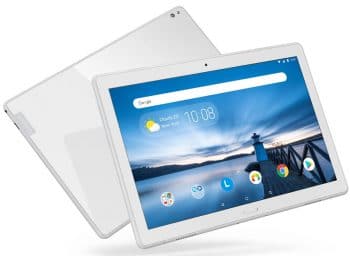 The Lenovo Tab P10 has many good premium features at an affordable price. In fact, the speakers, the fingerprint scanner, and the design are quite high-end. Other aspects like the display and performance are good too.
The Lenovo Tab P10 has many good premium features at an affordable price. In fact, the speakers, the fingerprint scanner, and the design are quite high-end. Other aspects like the display and performance are good too.
Technical specifications
- Dimensions: (D x W x H; weight): 7mm x 167mm x 242mm; 440g
- CPU: Qualcomm Snapdragon 450, octa-core 1.8GHz ARM Cortex A53
- Display: 25.6cm IPS LCD with a resolution of 1200 x 1920 px, capacitive touchscreen with multi-touch, 224 ppi
- Camera: 8MP (rear) + 5MP (front) with auto-focus, continuous shooting, face detection, HDR, panorama, geo-tagging
- Memory: 4GB RAM + 64GB ROM + support for microSD card of up to 128GB
- Connectivity: Wi-Fi 802.11 a/b/g/n/ac + 802.11n 5GHz, dual band, Wi-Fi display/direct and hotspot, Bluetooth 4.2, GPS, A-GPS, GLONASS, USB Type C with OTG, 3.5mm audio jack
- Sensor: Fingerprint, accelerometer, Hall sensor, ambient light sensor
- Speakers: Dolby Atmos audio
- Battery: 7000mAh—lithium polymer
- Software: Android 8.0 Oreo
Pros: Good performance, contrast and display; great battery life, nice camera performance, loud music, stock Android experience, front-facing speakers
Cons: Slow WLAN, no brightness sensor, screen is a fingerprint magnet, weak reception on GPS module, outdated security patches
Samsung Galaxy Tab A 10.5 is a mid-level tablet with a 26.6cm full HD display, a Snapdragon 450 octa-core processor and Android 8.1 Oreo OS. In addition, it has some premium features like four speakers and can be unlocked using facial recognition.
The Galaxy Tab A 10.5 is a big tablet, and has a large bezel around the display. Thanks to a soft-touch rubber back, the tablet offers excellent grip and doesn’t make you fear for its safety.
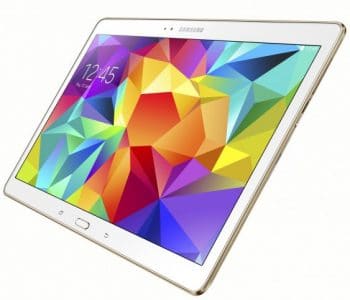 The Tab A 10.5 has software navigation keys instead of Samsung’s traditional physical home button, and capacitive back and recent apps keys. The tablet is something of an oddball when it comes to performance — good at games like Modern Combat 5 and PUBG at the highest graphical settings.
The Tab A 10.5 has software navigation keys instead of Samsung’s traditional physical home button, and capacitive back and recent apps keys. The tablet is something of an oddball when it comes to performance — good at games like Modern Combat 5 and PUBG at the highest graphical settings.
Technical specifications
- Dimensions (H x W x D; weight): 260mm x 161.1mm x 8mm; 529g
- CPU: Qualcomm SDM450 Snapdragon, octa-core, 1.8 GHz Cortex A53
- Display: IPS LCS capacitive 26.6cm screen with 1200 x 1900 px, 16:10 aspect ratio, 216 ppi
- Camera: 8MP (rear) f1.9 with LED Flash and panorama; 5MP (front) and supports 1080p@30fps video recording
- Memory: 3GB RAM + 32GB ROM + expandable via microSD card for up to 400GB
- Connectivity: Wi-Fi 802.11 a/b/g/n/ac, dual-band, Wi-Fi direct, hotspot, Bluetooth 4.2+A2DP, GPS, A-GPS, GLONASS, BDS, USB 2.0 Type-C, 3.5mm jack
- Sensors: Accelerometer, gyroscope, compass, RGB, Hall sensor
- Speakers: Four speakers with Dolby Atmos sound
- Battery: 7300mAh
- Software: Android 8.1 Oreo
Pros: Vibrant full HD screen, nice speaker audio, decent battery life, 4G and dedicated card slot, superb performance
Cons: Full plastic body, facial recognition not too good, expensive, no HD streaming on Netflix and Amazon Prime, poor cameras, limited accessories
Acer Iconia One 10 (B3-A50) is a powerful, ‘total value for money’ tablet with a great display and powerful speakers. The screen is big and sharp, measuring 24.5cm across and with a resolution of 1,200 x 1,920 – which amounts to 222 ppi. It has an IPS panel with a 16:10 aspect ratio, and is almost perfect for widescreen viewing.
![]() The Iconia tablet also has another trick up its sleeve, one that many manufacturers have dropped in recent years — two front-firing speakers. These are boosted by ‘DTS-HD Premium Sound’, which appears to be a mysterious automatic-equaliser that certainly has a positive impact on the sound produced.
The Iconia tablet also has another trick up its sleeve, one that many manufacturers have dropped in recent years — two front-firing speakers. These are boosted by ‘DTS-HD Premium Sound’, which appears to be a mysterious automatic-equaliser that certainly has a positive impact on the sound produced.
The Acer tablet has another feature that is often woefully absent from many similarly priced devices — full 802.11ac 5GHz Wi-Fi. This inclusion allows for blisteringly fast connectivity when paired with compatible routers and a reliable Internet connection.
Technical specifications
- Dimensions (H x W x D; weight): 170mm x 253.9mm x 8.3mm; 530g
- CPU: MediaTek MT8176 dual core, ARM and quad-core ARM Cortex A53 processor with 1.3GHz
- Display: 24.5cm WUXGA IPS technology with a resolution of 1280 x 800 px with Active Matrix TFT Colour LCD, 149 ppi
- Camera: 5MP (rear) + 2MP (front) with continuous shooting, auto-focus, digital zoom, HDR, face detection, self-timer
- Memory: 2GB RAM + 32GB eMMC + support for microSD card of up to 128 GB
- Connectivity: Bluetooth 4.1 + A2DP, 802.11 a/b/g/n/ac, micro USB
- Sensors: Accelerometer
- Speakers: 2x stereo speakers
- Battery: 6100mAh Li-ion
- Software: Android 8.1 Oreo
Pros: Simple design, good connectivity options, good performance,
Cons: Average display, average battery life, average camera performance
Chuwi Hi9 Plus is a decent Android 8.0 tablet that has an optional, attachable keyboard via a pogo port, and an active stylus support.
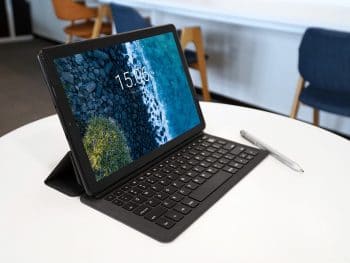 The build of the tablet is good with nice rounded edges, slim body and 2.5D glass. The screen is fully laminated, with a good maximum brightness of 360 lux. The screen’s white balance and colours can be tweaked to the users’ preference with the Miravision app included in the display settings. The Hi9 Plus has wireless AC dual band and Bluetooth 4.2. The battery is good — almost great — on this tablet. Overall, this a great tablet, with a good build, great screen, fast wireless, 4G support, phone calls, GPS, voice calls; but sometimes, the performance lags.
The build of the tablet is good with nice rounded edges, slim body and 2.5D glass. The screen is fully laminated, with a good maximum brightness of 360 lux. The screen’s white balance and colours can be tweaked to the users’ preference with the Miravision app included in the display settings. The Hi9 Plus has wireless AC dual band and Bluetooth 4.2. The battery is good — almost great — on this tablet. Overall, this a great tablet, with a good build, great screen, fast wireless, 4G support, phone calls, GPS, voice calls; but sometimes, the performance lags.
Technical specifications
- Dimensions: (H x W x D; weight): 8.1mm x 266mm x 177mm; 700g
- CPU: Deca Core 2×2.3GHz Cortex-A72 + 4×1.85GHz Cortex-A53 + 4×1.4GHz Cortex-A53 MediaTek Helio X20 MT6797
- Display: 20.3cm IPS, LCD QHD+ with 2560 x 1600px, 280ppi
- Camera: 8MP (front + back)
- Memory: 4GB RAM + 128GB ROM + support for microSD card up to 128 GB
- Connectivity: Wi-Fi 802.11 a/b/g/n/ac 2.4 G + 5G, dual band, Bluetooth 4.1+ A2DP, GPS, A-GPS, GLONASS, Mini USB 2.0 with OTG, USB Type-C, 3.5mm headphone jack
- Sensors: Accelerometer, G-sensor, proxy-sensor
- Speakers: Loudspeaker
- Battery: 7000mAh
- Software: Android 8.0 Oreo
Pros: Vibrant display, fast processor, stock Android experience, good battery life with Fast Charge support
Cons: No Corning Gorilla glass, camera and speaker quality below average, plastic side buttons
Xiaomi Mi Pad 4 Plus series has now reached its fourth generation. The 20.3cm Android tablet is available in three variants: 3GB of RAM and 32GB of storage, 4GB of RAM and 64GB of storage, or the second option but with LTE and GPS modules too.
Xiaomi has made some significant improvements to its budget Mi Pad, reducing the overall dimensions of this 20.3cm tablet so that it’s easier to use in one hand, upgrading the core hardware for decent performance, adding microSD support up to 256GB, and moving the speakers to a more suitable position on the bottom edge. This Mi Pad 4 is right up there with the best budget tablets. Although its screen has an aspect ratio of 16:10, it still appears longer. The Xiaomi Mi Pad 4 Plus also adopts an integrated metal body and the surface is sandblasted. So, it’s very pleasing to the touch. The top part is designed to ensure the wireless signal and the antenna part does the same for the network signal. Overall, the Xiaomi Mi Pad 4 Plus builds a complete audio and video experience with its own converged video platform.
Technical specifications
- Dimensions: (H x W x D; weight): 245.6mm x 149.1mm x 8mm; 485g
- CPU: Qualcomm Snapdragon 660 MSM8976 Plus with octa core (4 x 2.2GHz Kryo 260 + 4 x 1.84 GHz Kryo 260), CPU clock
- Display: 20.3cm WQXGA- 1920 x 1200 px, 1000:1 contrast ratio with 224 ppi
- Camera: 13MP (rear)- 4160 x 3120px with f/2.0 + 5 MP (front) with f/2.0 and auto-focus, continuous shooting, digital zoom, image stabilisation, geo-tagging, HDR, self-timer with 1080p @30fps video recording
- Memory: 4GB RAM + 64GB/128 GB ROM + support for microSD card up to 256 GB
- Connectivity: Wi-Fi 802.11 b/g/n, MIMO, hotspot, GPS, A-GPS, GLONASS, BeiDou, dual band, Bluetooth 5.0 + A2DP + HID, 3.5mm audio jack
- Sensors: Light, accelerometer, Hall, gyroscope, compass, proximity, fingerprint
- Speakers: Loudspeaker
- Battery: 8620mAh Li-polymer non-replaceable
- Software: Android 8.1 Oreo
Pros: Good display, nice price, active noise cancellation with microphone, nice battery life
Cons: No Corning Gorilla glass, no IR port, no FM, non-removable battery, no front speaker
































































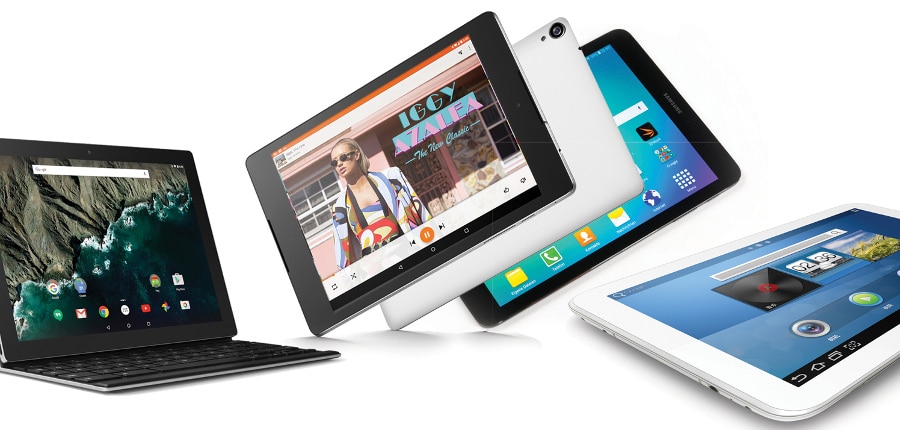
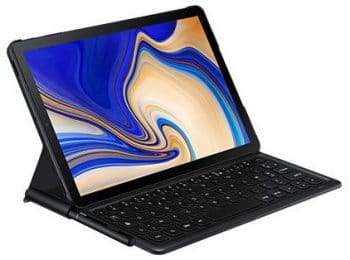
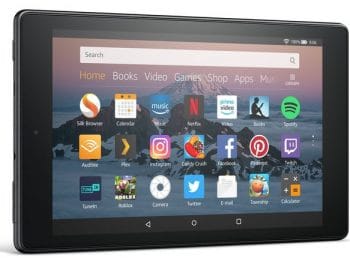
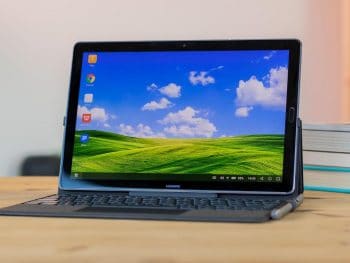
















Is Amazon Fire HD 8 (2018) tablet available in India? If not, does it work with full functionality if bought in US and brought to India for use?